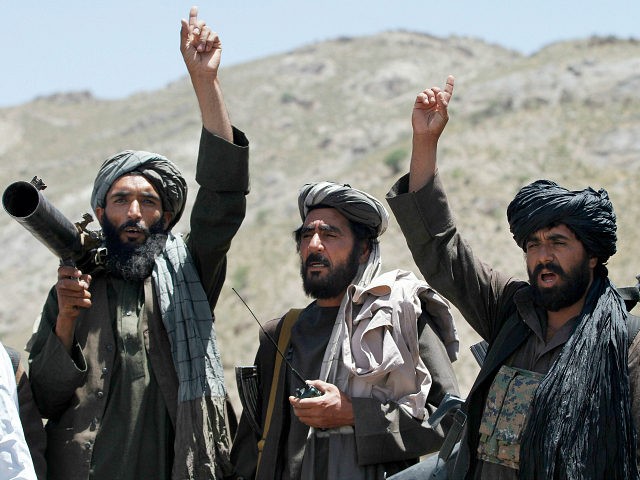Taliban jihadists control or contest 45 percent of Afghanistan as U.S. President Donald Trump begins to escalate the American military footprint in the country, reports the Long War Journal (LWJ), echoing assessments from the United States government and the terrorist group itself.
Using the LWJ and United Nations data, Breitbart News has found that the magnitude of the Taliban’s reach in Afghanistan is of historic proportions — the terrorist group currently holds more territory than at any other time since the U.S. military dethroned its regime in late 2001.
As part of U.S. President Donald Trump’s recently unveiled Afghan war strategy, the Pentagon has authorized the deployment of 3,000 additional American troops to shore up security, bringing the total number to about 14,000.
LWJ, a component of the Foundation for the Defense of Democracies (FDD) think-tank, reports:
Overall, LWJ has determined that 45 percent of Afghanistan’s districts are controlled or contested by the Taliban.
…
FDD’s Long War Journal assessment aligns closely with those of both the US military and the Taliban itself. The Taliban claims to control or contest 50 percent of the country’s 407 districts. The US military puts the estimate at 40 percent (note that LWJ believes that the US military’s assessment of Taliban controlled and contested districts is flawed).
The LWJ data shows the Taliban controls 41 districts, contests 118, and has made “unconfirmable” claims of having conquered an additional 24 — for a total of 183 (45 percent) of the total 407 districts.
Most of the Taliban-held territory is reportedly concentrated in rural Afghanistan, something that LWJ believes the U.S. military tends to downplay.
“Our assessment highlights the Taliban’s rural control, a key source of insurgent strength that the US military underestimates. The coalition and Afghan government cannot roll back Taliban gains or ultimately defeat it while ignoring the Taliban’s rural advantage,” notes the outlet in its report, adding:
The US military and Afghan security forces tend to emphasize urban control in assessing the Taliban’s strength and downplay the Taliban’s control of rural areas. In recent SIGAR [U.S. Special Inspector General for Afghanistan Reconstruction] reports, the US military has described these rural regions controlled or contested by the Taliban as “less vital areas” that have “less strategic importance.”
This urban focus underestimates the Taliban and its strategy to leverage control of rural areas to launch attacks against urban centers.
SIGAR is a congressionally-appointed watchdog agency.
The United Nations had determined that, as of the end of October 2015, the Taliban had conquered more territory than during any other time since the Afghanistan war began in 2001.
Citing the U.S. military, SIGAR reported to Congress that, by late November 2015, jihadist groups, primarily the Taliban, controlled or contested a little over 28 percent of Afghanistan.
The area controlled by the Taliban has only increased since the U.N. reported that the terrorist group’s influence had reached historic levels in 2015.
In its most recent report to Congress, SIGAR notes that terrorist groups, mostly the Taliban, controlled or contested 40 percent of Afghanistan, a number that has been disputed by LWJ.
Along with the area controlled by the Taliban, the number of attacks carried out by the group has reached levels not seen since 2001 when the jihadi organization’s regime was in power.
Early this year, the U.N. reported:
The security situation in Afghanistan remained intensely volatile. UNAMA [United Nations Assistance Mission in Afghanistan] recorded 5,687 security-related incidents in Afghanistan between January and the end of March 2017, the highest total ever recorded for that period since 2001.
…
The conflict continued unabated throughout the country … By the end of August 2017, the United Nations had recorded more than 16,290 security-related incidents for the first eight months of the year.
The U.N. attributed most of the attacks in Afghanistan to the Taliban, the most prominent terrorist group in the country.
More territory has allowed the Taliban to expand its efforts to cultivate opium, a lucrative source of funding used to pay for terrorist attacks.
Since 2010, skyrocketing production of deadly opium and its heroin derivative has “shown a closer correlation with rising terrorist attacks,” noted the U.N. this year.
Under former U.S. President Barack Obama’s watch, the area under opium cultivation reached unprecedented quantities in Afghanistan, the world’s top supplier of the illicit drug.
Echoing the U.N., the U.S. military has reported that opium production provides about 60 percent of the Taliban’s estimated $400 million annual income.
Much of the area controlled by the Taliban lies along the Afghanistan-Pakistan border, particularly in the southern Afghan province of Helmand, the top opium-producing region in the country.
The Taliban and its allies — al-Qaeda and the Haqqani Network — are not the only game in town.
Their alleged rival, the Islamic State (ISIS/ISIL) has also strengthened its presence and influence in the country, spreading its tentacles from one to seven provinces in recent months, reported the U.N.
The ISIS wing in Afghanistan has reportedly fueled the deteriorating conditions in the country, nearly doubling its attacks to 237 in just the first half of this year, from the 128 during the same period in 2016.

COMMENTS
Please let us know if you're having issues with commenting.